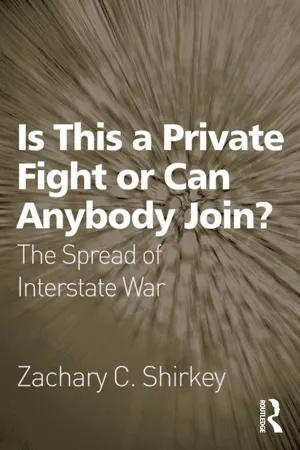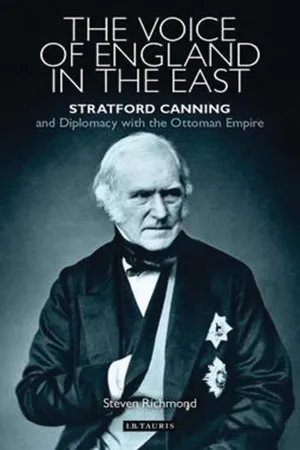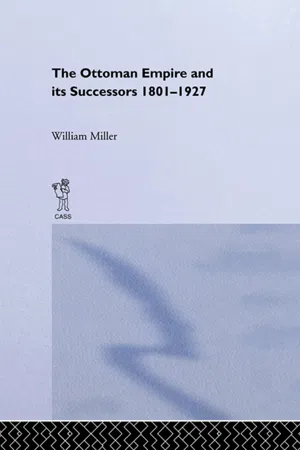History
Crimean War
The Crimean War was a conflict fought from 1853 to 1856 between Russia and an alliance of France, Britain, the Ottoman Empire, and Sardinia. It was sparked by religious and territorial disputes in the Middle East and the Black Sea region. The war resulted in significant loss of life and had long-term implications for European power dynamics and military tactics.
Written by Perlego with AI-assistance
Related key terms
4 Key excerpts on "Crimean War"
- eBook - ePub
Is This a Private Fight or Can Anybody Join?
The Spread of Interstate War
- Zachary C. Shirkey(Author)
- 2016(Publication Date)
- Routledge(Publisher)
Chapter 4The Crimean War: Public Opinion, Divided Cabinets, and the Partial Spread of War
The conqueror is always a lover of peace;he would prefer to take over our countryunopposed—Karl von Clausewitz1The Crimean War was an important watershed in European history. It destroyed the diplomatic system that had been set up by the Congress of Vienna. In particular, the war destroyed the Holy Alliance and, along with the revolutions of 1848, helped to unleash a period of instability and war in European politics. Its important place in history, however, is only a minor reason why the Crimean War was chosen as one of the case studies. The Crimean War began as one in the long series of Russo-Turkish wars of the 18th and 19th centuries, but unlike the other Russo-Turkish wars, grew to become a major European war. Two great powers and one minor power joined the war and several others considered joining or were thought likely to join by contemporaries. Thus, the war provides a contrast between those that joined and those that did not. The war is also interesting because of how long it took the British and French to join the Turkish side. Finally, the war illustrates quite clearly that the actions of belligerents in any war are to a large extent shaped by the possibility that outside states may join the war, even if those states never actually enter the war. Belligerents craft policies both to react to the actions of potential interveners and to influence the decisions of those potential interveners.2The chapter is structured in the following manner. First, the antebellum goals of the states that joined or reasonably could have joined are explored. This is necessary as it provides a base from which the later actions of the states involved can be understood. Second, the crisis leading to the war and the diplomatic exchanges during the war itself are reviewed. This discussion shows why certain states joined the war and why they joined when they did. Third, the events and causes that led to peace are reviewed. Finally, conclusions are drawn about the role unexpected events played in the spread and termination of the war. - eBook - ePub
Landscapes of Trauma
The Psychology of the Battlefield
- Nigel Hunt(Author)
- 2019(Publication Date)
- Routledge(Publisher)
10 The Crimean WarBattle of Balaklava. This is a battlefield fought over for longer and more intensely in the 1940s by the Germans and the Russians, and there is much evidence of this fighting. The best evidence for the Battle of Balaklava is the landscape itself. From the Sapoune Heights (from where Raglan tried to coordinate the battle), there is a good view of the Valley of Death, the key hills poorly defended by the Turks (including Canrobert’s Hill), and down to Balaklava, in front of which the marines fought as the ‘thin red line’. It is also the Sapoune Heights that contains much evidence from the 1940s’ battles, from tanks and guns through to trenches and concrete emplacements. The Valley of Death is now a vineyard.The Crimean War was a relatively small-scale war (though not for its participants) in the middle of a century that was, for the most part, relatively free of wars between the great European powers. After the defeat of Napoleon in 1815, the only significant direct conflict between these powers until World War I, apart from Crimea, was the Franco-Prussian War, dealt with in the next chapter. The Crimean War was fought over access through the Dardanelles for the Russian fleet. Turkey, Britain and France wanted to restrict Russian access. Russia needed access to the Mediterranean and beyond because it had few ice-free ports apart from Sevastopol on the Crimean Peninsula.The Crimean War was not the finest of wars fought by the Allies. There were more casualties due to illness and disease than through fighting, and the strategy was less than ideal. This is not the book to deal with these things in detail. The focus here is on the impact on those who took part in the war, drawn largely from the personal recollections of the participants. It is worth noting that Tolstoy fought here at the siege of Sevastopol, with his experiences informing his later work, such as War and Peace - eBook - ePub
The Voice of England in the East
Stratford Canning and Diplomacy with the Ottoman Empire
- Steven Richmond(Author)
- 2014(Publication Date)
- I.B. Tauris(Publisher)
PART V THE Crimean War, 1853–56Passage contains an image CHAPTER 14 ‘HEAVEN HELP ME!’ 1
Believing or hoping he was ‘perhaps never to return’,1 Stratford Canning began a leave from his post and quit Constantinople for home on HM Steam Sloop Scourge on 22 June 1852.2 He was already planning to resign the embassy and this he achieved in London a few months later, in January 1853. He was now 66 years old and had arrived at retirement from diplomacy and a relaxed secondary career in the House of Lords. The previous year he had been raised to the peerage as Viscount Stratford de Redcliffe after having nearly been appointed Secretary of State for Foreign Affairs in the new government of the Earl of Derby.3 He seemed at this point to have finally realised his dream of settling at home. But suddenly world events intervened, his diplomatic career was reactivated, he was returned to Constantinople and his journey was back on.The Crimean War is renowned for beginning with the ‘Holy Places dispute’ between the French and the Russians over the maintenance of Christian religious sites in Ottoman Palestine. The dispute had actually begun in 1842 and ran perennially as a problem no one thought would ever be solved or would ever cause major trouble. While it was indeed important in contributing to the explosion of tensions in 1853, the real spark came not from Palestine but from Montenegro. In early 1852 the armies of the Ottoman general Omer Paşa had occupied this region in response to a nationalist uprising there. These troops remained through the year and there was talk of war between the Ottoman and Austrian empires. Tsar Nicholas wrote to the Austrian emperor, Franz Joseph, that: ‘If war by Turkey against Thee should result, Thou mayest be assured in advance that it will be precisely the same as though Turkey had declared war on myself.’ On 30 December 1852 the Russians mobilised two army corps in the Danubian Principalities along its border with the Ottoman Empire. And on 13 January 1853, the Russians undertook naval operations in the Black Sea and mobilised two more army corps in the region. - eBook - ePub
- William Miller(Author)
- 2012(Publication Date)
- Routledge(Publisher)
Nearly two months, however, were spent at Varna before the expedition sailed; for, besides the time required for preparing the means of embarkation, nature protested against a prompt departure. Fire destroyed many of the British military stores; the crowded cemetery at Varna still bears silent witness to the ravages of cholera among the allied troops. It was not till September 13 that the allied fleets reached the Crimea; and on the following day a body of British troops occupied without opposition the port of Eupatoria. The main force landed near the lake of Kamishlu; and soon 37,000 French, 27,000 British, and 7000 Turks were encamped upon the shores of what was to most of them an absolutely unknown land. Only the Turks could claim some connexion with the country, for its natives shared their faith, and from 1475 in the time of Mohammed II till the latter part of the eighteenth century Crim Tartary, once the seat of Genoese colonisation, had been a part of the Ottoman empire. Only as recently as 1783 had it been finally incorporated by Catherine II in the Russian dominions. Thus in the Crimea began that secular strife between Turk and Muscovite, of which this war was not to be the last phase. On September 19 the allied armies started for Sebastopol. Their march led them to the stream of the Bulganak, where the first skirmish between the western forces and their enemy took place. Next day, on the banks of another river, since then more famous than many a greater stream, the Alma, they fought and won their first great battle. The Russians, commanded by Mentschikoff, who was now called to support his blustering diplomacy by force, were obliged to retreat after a struggle in which the British took the principal part, owing to the slowness of the French commander
Learn about this page
Index pages curate the most relevant extracts from our library of academic textbooks. They’ve been created using an in-house natural language model (NLM), each adding context and meaning to key research topics.



